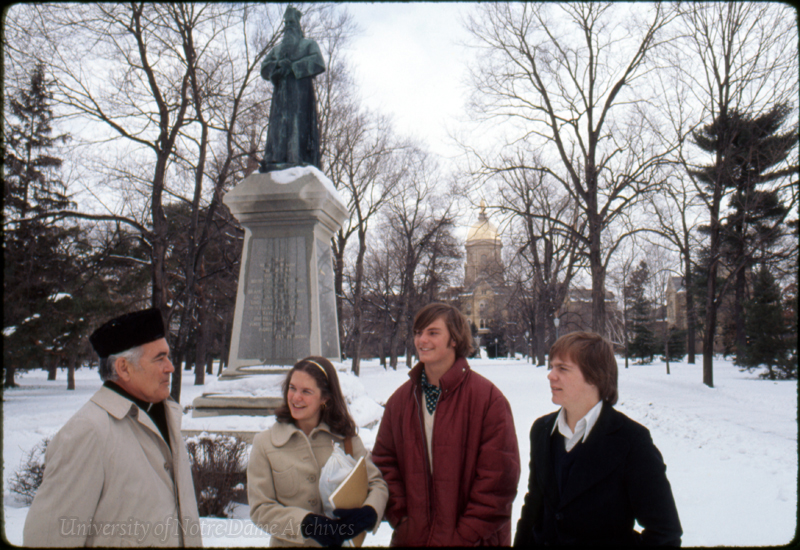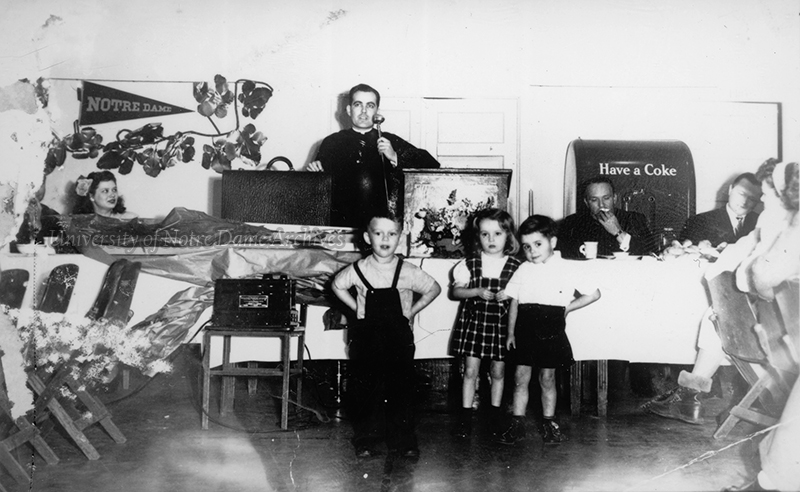 Caption
Caption
Source: University of Notre Dame Archives.
The Veterans Era: Vetville
Housing
With the end of the Veterans Club, Father Hesburgh directed his attention to a small, yet growing community within the University: the married veterans. Universities across the country were admitting married students for the first time. Married students came with their own needs, the most immediate of which was housing. Father Hesburgh became their chaplain and set out to help them in any way he could.
Several hundred families arrived at Notre Dame, only a portion of which were able to be housed on campus. So, Father Hesburgh recruited a student to scout the neighborhoods in South Bend to find suitable apartments. Father Hesburgh recalled in an interview, "None of them was very good, but we'd check them out, and I had all the housing complaints and learned how to be landlord." He kept track of the apartments and made sure that when one couple or family left, another was able to take their place.
The University was able to assist some couples by forming a little neighborhood on the east side of campus, which became known as Vetville. There were thirty-nine barracks, each was divided into three apartments, and each apartment rented at $28 per month. Because of the shortage of housing, due in part because of Notre Dame's lack of funds, but also the stiff competition for military surplus materials after the war, only married couples with at least one child could apply for housing at Vetville. Compared to similar housing on college campuses, the apartments at Vetville were quite nice. Though simple, they each had two bedrooms, a small kitchen, and a living room. Eventually, grass was planted and streets were paved. A writer for the South Bend Tribune described later improvements to the area, "Class after class of architects and artists, engineers and idea men have erected partitions and room divides, shelves, transoms, screened in porches and cement patios. Green-thumbed art students have turned the large vacant areas between the units into well-clipped lawns and rose gardens."
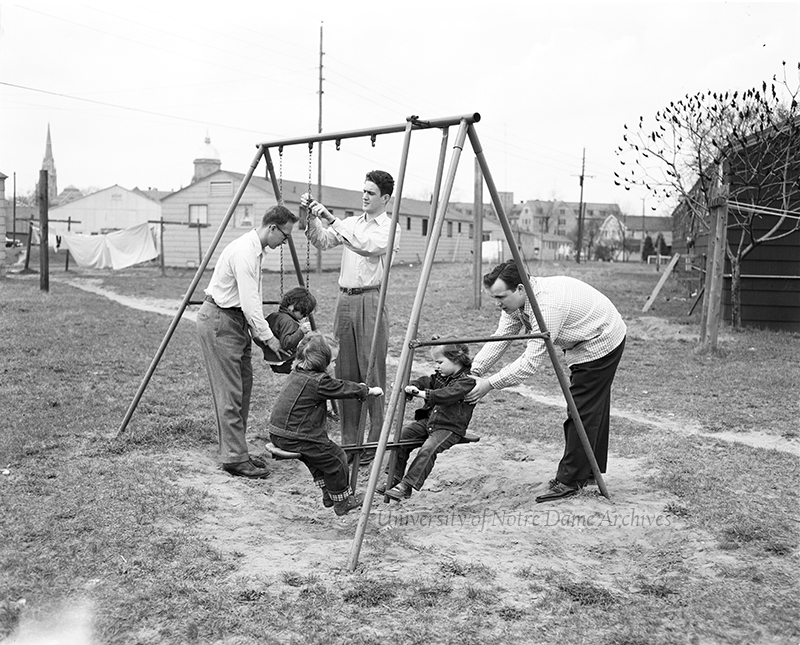
Source: University of Notre Dame Archives.
Community
In the fall of 1946, 117 families of Vetville settled into their new home at Notre Dame, where they created a tight-knit community that would be a part of campus for the next sixteen years.
The community shared babysitting duties, swapped children's and maternity clothing, and found cheap forms of entertainment, stretching their budgets as best as they could. The couples would attend football games (where there was special seating next to the student section for married couples), attend Glee Club concerts, watch free movies at Washington Hall, or host bridge tournaments. When another family was not available to babysit, they hired students or Father Hesburgh, in exchange for a piece of cake.
Despite the economic strain, the community averaged one hundred births per year. Father Hesburgh stated in a South Bend Tribune article about finding affordable care for these families, "We got the four best OB (obstetrics) doctors in town, and they agreed to do pre-delivery care, delivery and post-delivery for $75." Some of the religious sisters in the infirmary were kind and willing to take care of the wives and children of Vetville.
John Smith, a Notre Dame alumnus who wrote of his experience as a pre-war student and then later a member of Vetville in his book, Wouldn't Change a Thing, recalled, "having Vetville with its diaper-draped clotheslines spring up right in their midst was a unique and refreshing experience for the Notre Dame clergy. In short order the clergy became part of Vetville life and Vetville became a part of their world."
Recreation
Father Hesburgh was a regular fixture in the community and well respected. He spent much of his time, outside of teaching, visiting various apartments to meet families. Creating community was important to him, but the apartments weren't designed to accommodate large numbers, so gatherings were difficult to arrange. Father Hesburgh knew Vetville could use a regular meeting place for recreation and, as he put it, "to ease the tension of combining schoolwork, married life, and baby care." So, when he was in Washington, D.C. for business, he applied at a government office for a recreation hall from the surplus military materials. Within a few weeks, the large hall was trucked to campus at a very minimal expense to the University. Father Hesburgh recalled, "It had a couple of offices, a concrete floor, a stage, and a high ceiling. It was absolutely perfect for dances." They got student musicians to play and held Saturday night dances for the couples of Vetville. Admission was twenty-five cents, enough to cover the cost of beverages.
The Rec Hall was also used for lecture series for the wives of Vetville. Father Hesburgh started the series, which continued well beyond his time as chaplain. A South Bend Tribune article mentioned on and off-campus educational opportunities for the wives, "Classes have been conducted in the village recreation hall in such subjects as child psychology, religion and the Great Books." It added that "many wives drive to South Bend for University of Indiana extension courses."
Whether women were working, getting an education, or at home taking care of children, Father Hesburgh respected them greatly. He felt that they should be honored when their husbands graduated from Notre Dame, so he began signing "diplomas" for them, and eventually got President John Cavanaugh to do the same. Years later, Father Hesburgh recalled in a South Bend Tribune article, "Anyone reading it would know it was just something fun. But whenever I would go to the homes of these people, I would always see the diploma framed on the wall." He recognized that much of the success of the men was due, in large part, to the hard work and sacrifice of the women, and wanted to convey that to them.
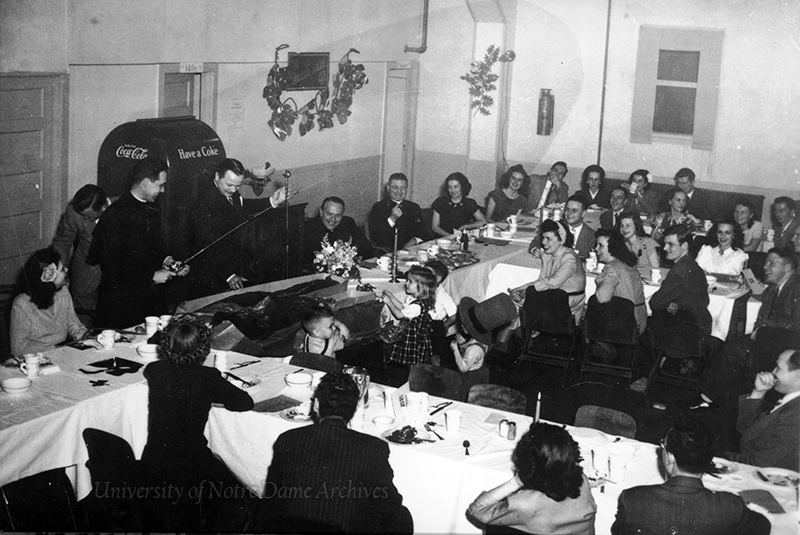
Source: University of Notre Dame Archives.
The Vet Gazette
The Vetville City Council also met in the Rec Hall, as did the Vetville News (later, the Vet Gazette), which was started in February 1947. The paper was not only a way to share community news, but provided an opportunity for the young families to get to know each other. Father Hesburgh recalled, "We really had a lot of fun with that Vet Gazette. It turned out to be a kind of glue for that community." The paper was filled with local happenings, social events, the "Kitchen Korner" with recipes and household hints, baby announcements, a "Family of the Week" feature, advertisements, sporting events, and "The Word" from Vetville's chaplain started by Father Hesburgh.
Though initially concerned with practical issues, Father Hesburgh sought a way to reach all the couples of Vetville and began writing "The Word" on a weekly basis. He addressed faith, the sacraments, and various aspects of marriage, family, and community life. He also addressed the Church's stance on birth control, counteracting the divorce mentality in the country, and practical ways in which to build a strong, faith-filled family.
Ministry and Prayer
Father Hesburgh attended to a great many needs within the Vetville community, including helping couples work out difficulties. He recalled in his autobiography, "The more involved I got, the more I found myself functioning as a marriage counselor in Vetville, and that led me to an interest in the dynamics of marriage-the spirituality, the psychology and the sociology involved in holy matrimony. These young couples, I decided, needed a course on marriage at the university. They knew so little." He saw the effects of broken families when he worked at the reform school for boys in Washington, D.C.. "Good marriages were terribly important in the lives of these young people and the children they would produce." So Father Hesburgh studied the subject, reading a few dozen books, and got approval to teach a new course called "Marriage and the Family," which was popular and well received. He also led marriage retreats.
One of Father Hesburgh's greatest joys was being a part of this community, ministering to the couples, and baptizing most of the newest members of these families, either in parishes of South Bend or at Sacred Heart on campus. But he was also a calming presence during difficult times. Father was there for a young couple who lost their nine-month-old daughter to spinal meningitis. The families of Vetville had little to give, but showed their support for the family in need. He recalled later, "the parents wanted to bury their daughter back in Connecticut. I remember going around with a milk bottle full of nickels and dimes and pennies. Yet we raised about a hundred and ten bucks, which in those day was enough to take the two of them in a plane back to Darien, Connecticut, for the funeral."
Former resident, John Smith, recalled Father Hesburgh's presence in his family's time of need.
When he was about three, Carey gave us a real scare. He came down with pneumonia. After the doctor had given us the bad news, JoAnn called our chaplain, Father Hesburgh, and asked him to remember Carey in his prayers. The chaplain came right over to unit 6-B and the prayer vigil got underway on site. Right on schedule, Carey's temperature broke and he was on the way to recovery. JoAnn and I are truly grateful to Father Ted for his private demonstration that prayer works.

Source: University of Notre Dame Archives.
Another Move
Father Hesburgh recalled in his autobiography, "With my teaching, writing, and chaplaincy of Vetville, I was more than content. I was as busy and happy as I had been at any time in my life. I considered myself fortunate indeed, and was perfectly happy to continue for the rest of my life doing what I was then doing." But God had other plans. And in the summer of 1948, Father Cavanaugh sent Father Hesburgh to Farley Hall to be rector. In September, Father Hesburgh was made chair of the religion department. He wrote his last "The Word" in the Vet Gazette:
It's been wonderful watching Vetville grow from a few mangy looking barracks on a mud flat, to a lot of cherry [sic] homes filling out the ideal of the Christian family. It's been grand watching the children grow, watching the parents mature with their growing responsibilities, sharing a lot of family joys and sorrows. I'll never forget some wonderful moments of crisis when the village came through to help others in trouble. It's hard to say how many times I've been edified by the growing spirit of comradeship and community working together.
. . . Those who have left often write back to say how much they miss the wonderful spirit that gladdened their lives while they were out here. We have to keep that spirit going and growing yet, for there are a lot of people watching Vetville for even greater things. I'm sure of one character who will be watching and praying for all of you from across the road.
Although he accepted more and more responsibilities at Notre Dame, Father Hesburgh continued to be a part of regular Vetville reunions. He had to move on from this chapter of his life, but he would always hold the families of Vetville dear to his heart.
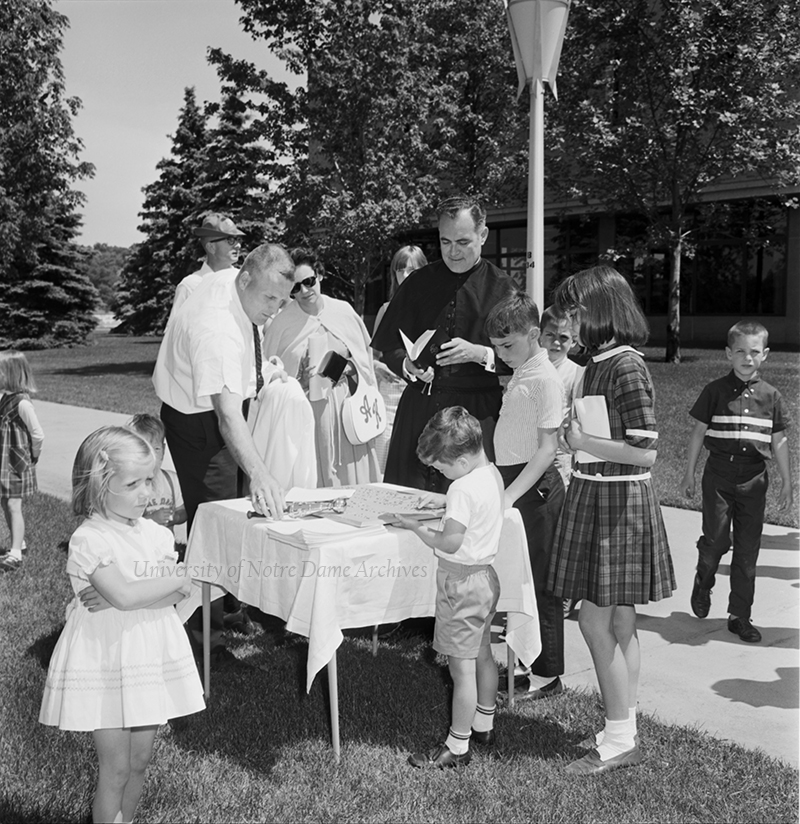
Source: University of Notre Dame Archives.
